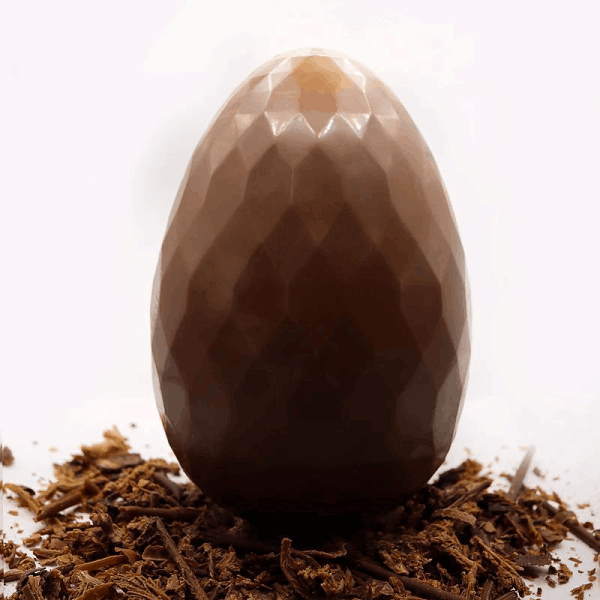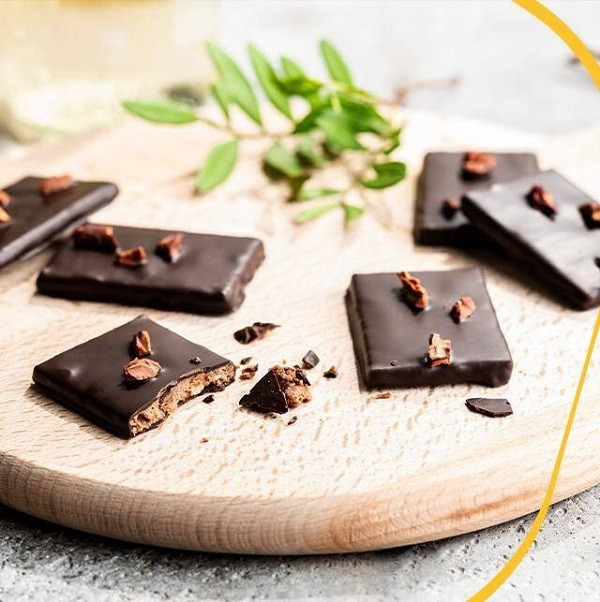✕

Column: industry Tag: chocolate,cacaofruit,Easter eggs Published: 2023-04-06 09:59 Source: www.foodingredientsfirst.com Author: Benjamin Ferrer,James Davies
As Easter approaches, sustainability in the chocolate and cocoa supply chain comes into heightened focus. FoodIngredientsFirst looks at a range of projects and innovations, including how WNWN Food Labs is looking to entirely subtract the cacao ingredient from the chocolate equation with what it claims is the world’s first cocoa-free chocolate Easter egg, developed by its in-house chocolatier.

(Image Credit: WNWN Food Labs).
Meanwhile, Barry Callebaut’s brand Cabosse Naturals underscores that waste reduction is a key part of sustainability efforts.
WNWN Food Labs, which brands itself as an alternative chocolate company, has leveraged a proprietary fermentation process to transform widely available plant-based ingredients like cereals and legumes to create cocoa-free chocolate that “tastes, melts, snaps and bakes just like conventional chocolate.”
“Having launched the first cocoa-free chocolate products, we recognized an opportunity to create the first, and currently only, cocoa-free chocolate egg, to show that Easter should be celebrated ethically and sustainably,” remarks WNWN chief technology officer, Dr. Johnny Drain.
“While this is not yet a consumer product, due to our scale-up efforts, you shouldn’t be surprised to see the Wegg in baskets next year.”
The Wegg is vegan, caffeine-free, gluten-free, palm oil-free and lower in sugar than comparable products, notes its producer. Cocoa-free WNWN products are claimed to produce 80% fewer carbon emissions than conventional chocolates, based on an internal life cycle analysis.
The Wegg is also 15 cm high and 10 cm wide, weighs approximately 100 grams, and has nutty, malty notes with a smooth dulce de leche finish and inside the Wegg is a “surprise filling.”
Cacaofruit: Upcycling to combat food waste
Global chocolate chain management is under heightened pressure from climate change and consumer scrutiny of non-ethical farming practices, so innovations that push sustainable alternatives are increasingly in the spotlight.
Sustainability efforts concentrated on upcycling ingredients are also a key part of creating better-for-you products with green credentials.
Two and a half years ago, Cabosse Naturals launched a new way of upcycling the often-discarded cacaofruit into a line of ingredients, including cacaofruit juice, pulp, concentrate and powder.

Cabosse Naturals is calling on producers to embrace upcycling methodologies aimed at wasting as little as possible (Image Credit: Cabosse Naturals).
And now, as Stop Food Waste Day approaches on April 26, the Barry Callebaut brand is calling on producers to embrace upcycling methodologies and similar initiatives aimed at wasting as little as possible during chocolate production.
“For centuries, the industry has focused on the seeds for chocolate and cocoa production. Over time, the association with the fruit has been lost,” Sylvie Woltering-Valat, head of marketing at Cabosse Naturals, tells FoodIngredientsFirst.
“We believe it’s the most wasted fruit on the planet, with 70% of it being thrown away once its seeds have been harvested,” she says.
Cacaofruit’s pulp has “a clean, fresh white color and a sweet scent of honey,” which Cabosse Naturals presses and converts into a concentrate. The resulting juice creates a “refreshing fruit base” for various functional beverages, teas, coffees and even beers.
“By discovering cacaofruit and using these new and exciting ingredients, producers and manufacturers will be able to launch new ranges of food and drink that offers a unique taste and empowers consumers to create a positive impact with their purchases,” notes Woltering-Valat.
She also underscores that waste reduction is a crucial part of sustainability efforts.
“Reducing food waste is the single greatest way of fighting climate change. According to the UK Food Standard Agency, this is the number one concern for British consumers when food shopping,” she flags. “It is also a key contributor to the rise in the upcycling food trend.”
“Pioneering brands worldwide have already jumped upon this trend and we anticipate more products will be launched over the coming year,” she says.
Upcycling is trending among companies that aim to boost sustainability while reducing costs by giving new life to ingredients that previously went to waste.

Barry Callebaut’s brand Cabosse Naturals underscores that waste reduction is a key part of sustainability efforts. (Image: Credit: Cabosse Natural).
Demand has never been greater for upcycled ingredients, as signaled by Innova Market Insights’ Top Ten Trend for 2023, “Redefining Value”, which details how cost and value for money have become more important to more than half of F&B consumers worldwide. Today’s shoppers are increasingly exploring money-saving strategies, such as choosing lower-cost items and cooking from scratch.
At the same time, consumers tell Innova they have reduced food waste and upcycled or recycled more as part of their belt-tightening.
Taking score of cocoa
In other moves to protect the vulnerable crop, Be Slavery Free has released its “Chocolate Scorecard”, evaluating the sustainability claims of some of the world’s leading chocolate brands.
Consumers are increasingly concerned about deforestation, habitat destruction and unfair labor practices in the conventional chocolate supply chain. By 2050, cacao trees are expected to die out by almost 33% worldwide due to rising climate change, according to Harvard University.
Meanwhile, more than a million child laborers are estimated to work in Ivory Coast and Ghana, where three-quarters of the world’s cocoa is grown, according to University of Chicago data.
The latest release of Be Slavery Free’s annual Chocolate Scorecard is deemed the “biggest survey of its kind,” and rates the sourcing policies and practices of 56 of the world’s largest chocolate companies, including cocoa traders, processors and manufacturers and the private labels of retailers.
These account for 95% of global chocolate products, Easter eggs among them, and include giants such as Mars, Lindt, Nestlé, Mondelēz (Cadbury), Ferrero and Hershey.
The report also says that 25% of children are in the vicinity of farms during pesticide spraying, while 18% are directly involved in working with chemicals.
“To address this concerning issue, we asked companies if they have a policy to monitor, reduce or eliminate the exposure of children to pesticides. Shockingly, only 62% of the companies said yes,” flag the report authors.
Previous:Barry Callebaut appoints new CEO, half-year sales volumes drop
Next:FrieslandCampina and Agrifirm collaboration targets plant-based expansion using oat and soy crops
Hot key words
Hot Products
Popular Vendors